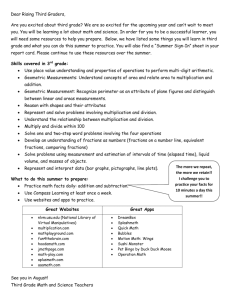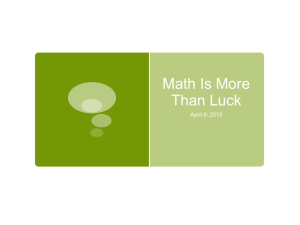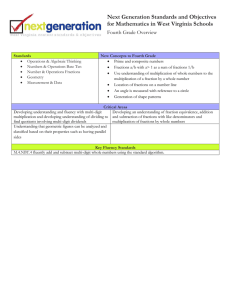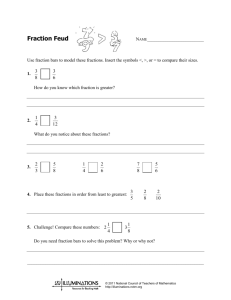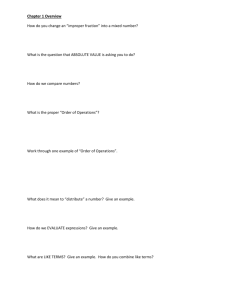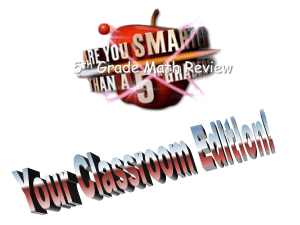GENERIC EVALUATION CRITERIA
advertisement
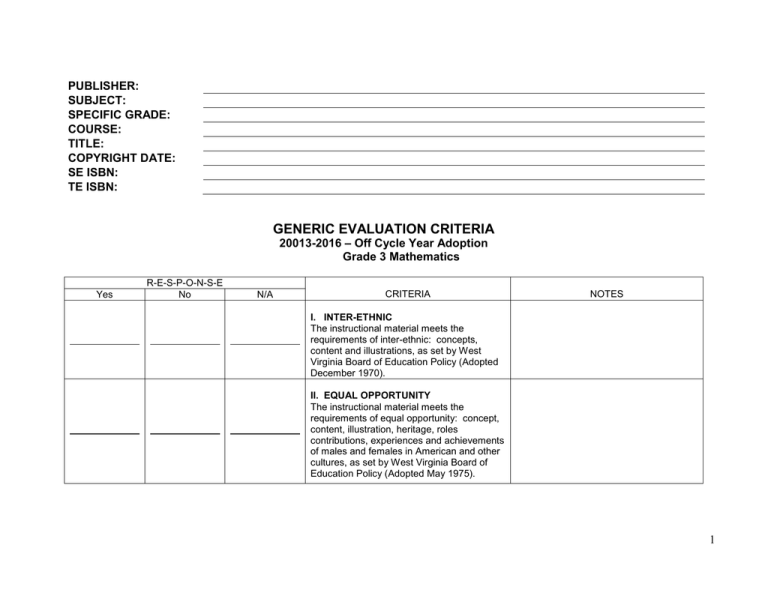
PUBLISHER: SUBJECT: SPECIFIC GRADE: COURSE: TITLE: COPYRIGHT DATE: SE ISBN: TE ISBN: GENERIC EVALUATION CRITERIA 20013-2016 – Off Cycle Year Adoption Grade 3 Mathematics Yes R-E-S-P-O-N-S-E No N/A CRITERIA NOTES I. INTER-ETHNIC The instructional material meets the requirements of inter-ethnic: concepts, content and illustrations, as set by West Virginia Board of Education Policy (Adopted December 1970). II. EQUAL OPPORTUNITY The instructional material meets the requirements of equal opportunity: concept, content, illustration, heritage, roles contributions, experiences and achievements of males and females in American and other cultures, as set by West Virginia Board of Education Policy (Adopted May 1975). 1 III. FORMAT The resource is available as an option for adoption in an interactive electronic format. INSTRUCTIONAL MATERIALS ADOPTION: 21st CENTURY LEARNING EVALUATION CRITERIA GENERAL EVALUATION CRITERIA 20013-2016 – Off Cycle Year Adoption Grade 3 Mathematics INSTRUCTIONAL MATERIALS ADOPTION: GENERAL EVALUATION CRITERIA The general evaluation criteria apply to each grade level and are to be evaluated for each grade level unless otherwise specified. These criteria consist of information critical to the development of all grade levels. In reading the general evaluation criteria and subsequent specific grade level criteria, e.g. means “examples of” and i.e. means that “each of” those items must be addressed. Eighty percent of the general criteria must be met with I (In-depth) or A (Adequate) in order to be recommended. 2 (Vendor/Publisher) SPECIFIC LOCATION OF CONTENT WITHIN PRODUCT (IMR Committee) Responses I=In-depth A=Adequate M=Minimal N=Nonexistent I A M N For student mastery of content standards and objectives, the instructional materials will provide students with the opportunity to apply: A. MATHEMATICAL PRACTICES 1. Make sense of problems and persevere in solving them. Explain to themselves the meaning of a problem and looking for entry points to its solution. Analyze givens, constraints, relationships, and goals Make conjectures about the form and meaning of the solution attempt. Plan a solution pathway rather than simply jumping into a solution. Consider analogous problems and try special cases and simpler forms of insight into its solution. Monitor and evaluate their progress and change course if necessary. Transform algebraic expressions or change the viewing window on their graphing calculator to get information. Explain correspondences between equations, verbal descriptions, tables, and graphs. Draw diagrams of important features and relationships, graph data, and search for regularity or trends. Use concrete objects or pictures to help conceptualize and solve a problem. Check their answers to problems using a different method. Ask themselves, “Does this make sense?” Understand the approaches of others to solving complex 3 problems and identify correspondences between approaches. 2. Reason abstractly and quantitatively. Make sense of quantities and their relationships in problem situations. Bring two complementary abilities to bear on problems involving quantitative relationships: o Decontextualize (abstract a given situation and represent it symbolically and manipulate the representing symbols as if they have a life of their own, without necessarily attending to their referents and o Contextualize (pause as needed during the manipulation process in order to probe into the referents for the symbols involved). Use quantitative reasoning that entails creating a coherent representation of the problem at hand, considering the units involved, and attending to the meaning of quantities, not just how to compute them Know and flexibly use different properties of operations and objects. 3. Construct viable arguments and critique the reasoning of others. Understand and use stated assumptions, definitions, and previously established results in constructing arguments. Make conjectures and build a logical progression of statements to explore the truth of their conjectures. Analyze situations by breaking them into cases Recognize and use counterexamples. Justify their conclusions, communicate them to others, and respond to the arguments of others. Reason inductively about data, making plausible arguments that take into account the context from which the data arose. Compare the effectiveness of plausible arguments. Distinguish correct logic or reasoning from that which is flawed 4 and, if there is a flaw, explain what it is o Elementary students construct arguments using concrete referents such as objects, drawings, diagrams, and actions. o Later students learn to determine domains to which an argument applies. Listen or read the arguments of others, decide whether they make sense, and ask useful question to clarify or improve arguments. 4. Model with mathematics. Apply the mathematics they know to solve problems arising in everyday life, society, and the workplace. o In early grades, this might be as simple as writing an addition equation to describe a situation. In middle grades, a student might apply proportional reasoning to plan a school event or analyze a problem in the community. o By high school, a student might use geometry to solve a design problem or use a function to describe how one quantity of interest depends on another. Make assumptions and approximations to simplify a complicated situation, realizing that these may need revision later. Identify important quantities in a practical situation Map their relationships using such tools as diagrams, two-way tables, graphs, flowcharts and formulas. Analyze those relationships mathematically to draw conclusions. Interpret their mathematical results in the context of the situation. Reflect on whether the results make sense, possibly improving the model if it has not served its purpose. 5. Use appropriate tools strategically. Consider available tools when solving a mathematical problem. (these tools might include pencil and paper, concrete models, a ruler, protractor, calculator, spreadsheet, computer algebra system, a statistical package, or dynamic geometry software. 5 Are sufficiently familiar with tools appropriate for their grade or course to make sound decisions about when each of these tools might be helpful, recognizing both the insight to be gained and their limitations. o High school students analyze graphs of functions and solutions generated using a graphing calculator Detect possible errors by using estimations and other mathematical knowledge. Know that technology can enable them to visualize the results of varying assumptions, explore consequences, and compare predictions with data. Identify relevant mathematical resources and use them to pose or solve problems. Use technological tools to explore and deepen their understanding of concepts. 6. Attend to precision. Try to communicate precisely to others. Try to use clear definitions in discussion with others and in their own reasoning. State the meaning of the symbols they choose, including using the equal sign consistently and appropriately. Specify units of measure and label axes to clarify the correspondence with quantities in a problem. Calculate accurately and efficiently, express numerical answers with a degree of precision appropriate for the problem context. o In the elementary grades, students give carefully formulated explanations to each other. o In high school, students have learned to examine claims and make explicit use of definitions. 7. Look for and make use of structure. Look closely to discern a pattern or structure. o Young students might notice that three and seven more is the same amount as seven and three more or they may sort a 6 collection of shapes according to how many sides the shapes have. o Later, students will see 7 x 8 equals the well remembered 7 x 5 + 7 x 3, in preparation for the distributive property. o In the expression x2 + 9x + 14, older students can see the 14 as 2 x 7 and the 9 as 2 + 7. They recognize the significance of an existing line in a geometric figure and can use the strategy of drawing an auxiliary line for solving problems. Step back for an overview and can shift perspective. See complicated things, such as some algebraic expressions, as single objects or composed of several objects. 8. Look for and express regularity in repeated reasoning. Notice if calculations are repeated. Look both for general methods and for shortcuts. o Upper elementary students might notice when dividing 25 by 11 that they are repeating the same calculations over and over again, and conclude they have a repeated decimal. o Middle school students might abstract the equation (y-2)/((x-1)=3 by paying attention to the calculation of slope as they repeatedly check whether the points are on the line through (1,2) with a slope 3. o Noticing the regularity in the way terms cancel when expanding (x-1)(x+1)(x2+1) and (x-1)(x3+x2+x+1) might lead high school students to the general formula for the sum of a geometric series. Maintain oversight of the process of solving a problem, while attending to the details. Continually evaluate the reasonableness of intermediate results. 7 SPECIFIC EVALUATION CRITERIA 20013-2016 – Off Cycle Year Adoption Grade 3 Mathematics In Grade 3, instructional time should focus on four critical areas: (1) developing understanding of multiplication and division and strategies for multiplication and division within 100; (2) developing understanding of fractions, especially unit fractions (fractions with numerator 1); (3) developing understanding of the structure of rectangular arrays and of area; and (4) describing and analyzing two-dimensional shapes. 1. Students develop an understanding of the meanings of multiplication and division of whole numbers through activities and problems involving equal-sized groups, arrays and area models; multiplication is finding an unknown product, and division is finding an unknown factor in these situations. For equal-sized group situations, division can require finding the unknown number of groups or the unknown group size. Students use properties of operations to calculate products of whole numbers, using increasingly sophisticated strategies based on these properties to solve multiplication and division problems involving single-digit factors. By comparing a variety of solution strategies, students learn the relationship between multiplication and division. 2. Students develop an understanding of fractions, beginning with unit fractions. Students view fractions in general as being built out of unit fractions, and they use fractions along with visual fraction models to represent parts of a whole. Students understand that the size of a fractional part is relative to the size of the whole. For example, 1/2 of the paint in a small bucket could be less paint than 1/3 of the paint in a larger bucket, but 1/3 of a ribbon is longer than 1/5 of the same ribbon because when the ribbon is divided into 3 equal parts, the parts are longer than when the ribbon is divided into 5 equal parts. Students are able to use fractions to represent numbers equal to, less than, and greater than one. They solve problems that involve comparing fractions by using visual fraction models and strategies based on noticing equal numerators or denominators. 3. Students recognize area as an attribute of two-dimensional regions. They measure the area of a shape by finding the total number of same-size units of area required to cover the shape without gaps or overlaps, a square with sides of unit length being the standard unit for measuring area. Students understand that rectangular arrays can be decomposed into identical rows or into identical columns. By decomposing rectangles into rectangular arrays of squares, students connect area to multiplication and justify using multiplication to determine the area of a rectangle. 4. Students describe, analyze, and compare properties of two-dimensional shapes. They compare and classify shapes by their sides and angles, and connect these with definitions of shapes. Students also relate their fraction work to geometry by expressing the area of part of a shape as a unit fraction of the whole. 8 (IMR Committee) Responses (Vendor/Publisher) SPECIFIC LOCATION OF CONTENT WITHIN PRODUCT I=In-depth A=Adequate M=Mi nimal N=Nonexistent I A M N For student mastery of content standards and objectives, the instructional materials will provide students with the opportunity to A. Operations & Algebraic Thinking Represent and solve problems involving multiplication and division. 1. interpret products of whole numbers, e.g., interpret 5 × 7 as the total number of objects in 5 groups of 7 objects each. For example, describe context in which a total number of objects can be expressed as 5 × 7. 2. interpret whole-number quotients of whole numbers, e.g., interpret 56 ÷ 8 as the number of objects in each share when 56 objects are partitioned equally into 8 shares, or as a number of shares when 56 objects are partitioned into equal shares of 8 objects each. For example, describe a context in which a number of shares or a number of groups can be expressed as 56 ÷ 8. 3. use multiplication and division within 100 to solve word problems in situations involving equal groups, arrays and measurement quantities, e.g., by using drawings and equations with a symbol for 9 the unknown number to represent the problem. 4. determine the unknown whole number in a multiplication or division equation relating three whole numbers. For example, determine the unknown number that makes the equation true in each of the equations 8× ? = 48, 5 = ? ÷ 3, 6 × 6 = ?. Understand properties of multiplication and the relationship between multiplication and division. 5. interpret products of whole numbers, e.g., interpret 5 × 7 as the total number of objects in 5 groups of 7 objects each. For example, describe context in which a total number of objects can be expressed as 5 × 7. 6. interpret whole-number quotients of whole numbers, e.g., interpret 56 ÷ 8 as the number of objects in each share when 56 objects are partitioned equally into 8 shares, or as a number of shares when 56 objects are partitioned into equal shares of 8 objects each. For example, describe a context in which a number of shares or a number of groups can be expressed as 56 ÷ 8. Multiply and divide within 100. 7. fluently multiply and divide within 100, using strategies such as the relationship between multiplication and division (e.g., knowing that 8 × 5 = 40, one knows 40 ÷ 5 = 8) or properties of operations and by the end of Grade 3, know from memory all products of two one-digit numbers. Solve problems involving the four operations, and identify and explain patterns in arithmetic. 8. solve two-step word problems using the four operations, represent these problems using equations with a letter standing for the unknown quantity and assess the reasonableness of answers using mental computation and estimation strategies including rounding. (This standard is limited to problems posed with whole numbers and having whole number answers; students should know how to perform operations in the conventional order when there are no parenthesis to specify a particular order (Order of Operations).) 9. identify arithmetic patterns (including patterns in the addition table or multiplication table) and explain them using properties of operations . For example, observe that 4 times a number is always even and explain why 4 times a number can be decomposed into two equal 10 addends. B. Number & Operations in Base Ten Use place value understanding and properties of operations to perform multi-digit arithmetic. 1. understand a fraction 1/b as the quantity formed by 1 part when a whole is partitioned into b equal parts and understand a fraction a/b as the quantity formed by a parts of size 1/b. 2. understand a fraction as a number on the number line and represent fractions on a number line diagram a. represent a fraction 1/b on a number line diagram by defining the interval from 0 to 1 as the whole and partitioning it into b equal parts and recognize that each part has size 1/b and that the endpoint of the part based at 0 locates the number 1/b on the number line. b. represent a fraction a/b on a number line diagram by marking off a lengths 1/b from 0 and recognize that the resulting interval has size a/b and that its endpoint locates the number a/b on the number line. 3. explain equivalence of fractions in special cases and compare fractions by reasoning about their size a. understand two fractions as equivalent (equal) if they are the same size or the same point on a number line, b. recognize and generate simple equivalent fractions, e.g., 1/2 = 2/4, 4/6 = 2/3) and explain why the fractions are equivalent, e.g., by using a visual fraction model, c. express whole numbers as fractions, and recognize fractions that are equivalent to whole numbers (Examples: Express 3 in the form 3 = 3/1; recognize that 6/1 = 6; locate 4/4 and 1 at the same point of a number line diagram.) d. compare two fractions with the same numerator or the same denominator by reasoning about their size, recognize that comparisons are valid only when the two fractions refer to the 11 same whole, record the results of comparisons with the symbols >, = or < and justify the conclusions, e.g., by using a visual fraction model. C. Measurement & Data Solve problems involving measurement and estimation of intervals of time, liquid volumes, and masses of objects. 1. tell and write time to the nearest minute, measure time intervals in minutes and solve word problems involving addition and subtraction of time intervals in minutes, e.g., by representing the problem on a number line diagram. 2. measure and estimate liquid volumes and masses of objects using standard units of grams (g), kilograms (kg) and liters (l) (Excludes compound units such as cm3 and finding the geometric volume of a container.) and subtract, multiply or divide to solve one-step word problems involving masses or volumes that are given in the same units, e.g., by using drawings (such as a beaker with a measurement scale) to represent the problem. (Excludes multiplicative comparison problems - problems involving notions of “times as much”.) Represent and interpret data. 3. draw a scaled picture graph and a scaled bar graph to represent a data set with several categories and solve one- and two-step “how many more” and “how many less” problems using information presented in scaled bar graphs. For example, draw a bar graph in which each square in the bar graph might represent 5 pets. 4. generate measurement data by measuring lengths using rulers marked with halves and fourths of an inch and show the data by 12 making a line plot, where the horizontal scale is marked off in appropriate units—whole numbers, halves or quarters. Geometric measurement: understand concepts of area and relate area to multiplication and to addition. 5 recognize area as an attribute of plane figures and understand concepts of area measurement a. a square with side length 1 unit, called “a unit square,” is said to have “one square unit” of area and can be used to measure area, b. a plane figure which can be covered without gaps or overlaps by n unit squares is said to have an area of n square units. 6 measure areas by counting unit squares (square cm, square m, square in, square ft and improvised units). 7 relate area to the operations of multiplication and addition a. find the area of a rectangle with whole-number side lengths by tiling it, and show that the area is the same as would be found by multiplying the side lengths, b. multiply side lengths to find areas of rectangles with whole number side lengths in the context of solving real world and mathematical problems and represent whole-number products as rectangular areas in mathematical reasoning, c. use tiling to show in a concrete case that the area of a rectangle with whole-number side lengths a and b + c is the sum of a × b and a × c and use area models to represent the distributive property in mathematical reasoning, d. recognize area as additive and find areas of rectilinear figures by decomposing them into non-overlapping rectangles and adding the areas of the non-overlapping parts, applying this technique to solve real world problems. Geometric measurement: recognize perimeter as an attribute of plane figures and distinguish between linear and area measures. 13 8 solve real world and mathematical problems involving perimeters of polygons, including finding the perimeter given the side lengths, finding an unknown side length and exhibiting rectangles with the same perimeter and different areas or with the same area and different perimeters. D. Geometry Reason with Shapes and Their Attributes 1. understand that shapes in different categories (e.g., rhombuses, rectangles and others) may share attributes (e.g., having four sides), that the shared attributes can define a larger category (e.g. quadrilaterals), recognize rhombuses, rectangles and squares as examples of quadrilaterals and draw examples of quadrilaterals that do not belong to any of these subcategories. 2. partition shapes into parts with equal areas and express the area of each part as a unit fraction of the whole. For example, partition a shape into 4 parts with equal area, and describe the area of each part as ¼ or the area of the shape. 14
